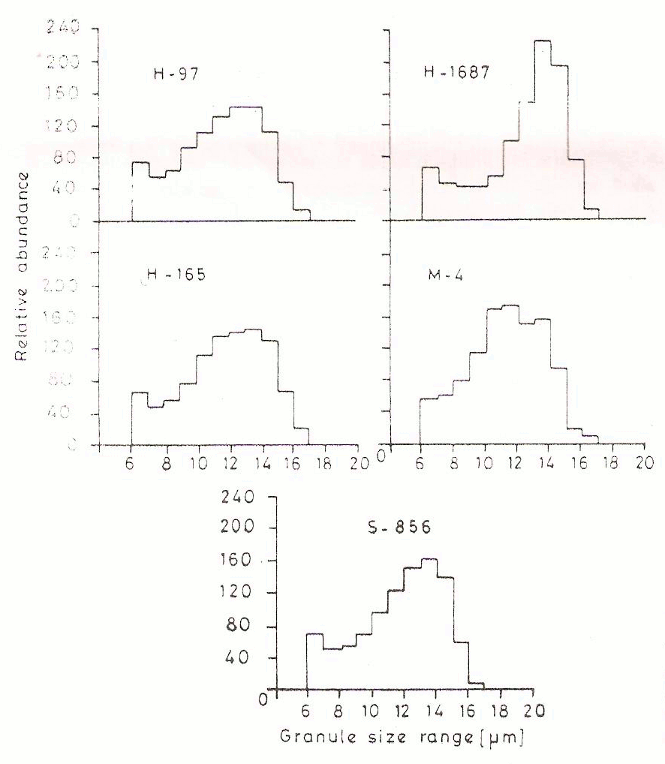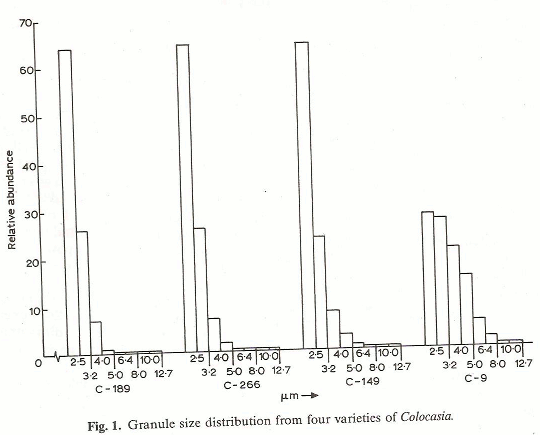Physicochemical and Functional Properties of Tropical Tuber Starches: A Review
Prev Page | Next Page- Introduction
- Extraction Techniques
- Other components in Starch
- Colour and Appearance
- Granule Shape and Size
- Spectral Features
- X-Ray Diffraction Pattern
- Molecular Weight
- Amylose Content
- Thermal Characteristics
- Gelatinisation and Pasting Temperatures
- Viscosity
- Swelling Power
- Solubility
- Clarity
- Sol stability
- Digestibility
- Conclusions
5. Granule Shape and Size
Wide variability in the size and shape of starch granules has been observed (Tab 3). These characteristics have been determined by simple optical microscopes, counters and electron microscopy.
-
Cassava Starch
Cassava starch granules are mostly round [5, 33, 45, 70-72] with a flat surface on one side containing a conical pit, which extends to a well-defined eccentric hilum. Some granules appear to be compound [73, 74]. Under polarized light, a well defined cross is observed. Though earlier studies on selected cassava varieties using microscopy did not reveal any noticeable variation in size among them (Tab 4) [81]. Examination of starch from five varieties using the Coulter Counter revealed considerable difference in the distribution pattern of the granule sizes (Fig 1). Thus starch from the H.1687 showed a higher frequency in the size range of 13-16 µm and relatively less in the range of 6-13μm compared to H165, H 97 and S 856 starches. Variety M4 also had a slightly different distribution pattern, but not as prominent as H-1687 starch [41]. Starch granule size was found too increase up to the sixth month with age of the crop for six varieties of cassava, and then remained steady [62]. Defloor et al. [75] concluded that the granule size was lower during the dry season and attributed it to the higher percentage of small granules during this period.
Table 3 : Ganular properties of different tuber starches
Starch Granule shape Granule size [µm] Reference Cassava Round, truncated, cylindrical, oval, spherical, compound 4-43, 3-32 [5,23,37,41,45,70-75], [77] Sweet potato Round, polygonal, oval, bell, round, polygonal 2-72, 11.1-19.4, 43 [21,25,27,46,76-78] [79], [25] C.esculenta round 1-10, 1-1.5, 0.3-3.3 [5,64,85-87,89], [23], [22] X.sagittifolium round 10-50, 17-20, 2.8-22 [5], [23], [22] Pachyrrhizus. erous Round, cupoliform or convex-biconcave polyhedral 6-35, 8-35 [5,31], [23] Arror root Round, polygonal 5-50 [5] A.paeoniifolus Round, polygonal 3-30 [5,91] Canna edulis Oval, polyhedral 5-43.5(mean) 13-57, 15-20, 60-14535 [41], [66], [23,89], [66] D.alata Oval, shell shaped, ellipsoid 16-100, 20-140, 5-50, 17-26, 10-50 [5], [89], [23], [22], [80] D.esculenta Round, oval, polyhedral, compound 2-15, 1-5, 1-5 [5], [89], [22] D.rotundata Oval, polyhedral oval, round triangular 10-70, 10-50, 15-70 [5], [80], [22] D.dumetorum Round, polygonal 1-3, 1-16, 3-5, 1-3 [89], [30], [80], [22] D.cayensis Polyhedral, ellipsoid 10-70, 10-50 [89], [80] Coleus round, oval 5-20, 2.5-15 [36], [33] Curcuma sp. Elliptical 14-46, 1.6-4.2 [67], [23] Table 4 : Effect of varietal difference on the physicochemical properties of cassava starch
Varieties Granule Size [µm] Reducing values 1 Amylose content Pasting Temp. [ 0C] Visc. 2% Paste3 XRD pattern Abs. Cryst. [%] Sw. Vol. [ml/g] Solubility Tonset [ 0C] DSC Data Tend [ 0C] ΔH [J/g] M-4 5.4-35.1 1.8 0.530 60.70 58.0 A 8.91 30.5 22.8 68.20 75.5 11.8 Kalikalan 5.4-40.5 1.8 0.550 63.70 58.0 – – 38.8 24.8 – – – H-1687 5.4-40.5 1.4 0.540 55.68 58.0 A 11.47 25.5 23.6 67.2 73.4 12.6 h-2304 5.4-43.2 1.4 0.525 52.68 55.0 – – 30.5 24.8 – – – H-226 5.4-43.2 1.8 0.500 55.66 56.0 – – 33.8 27.6 – – – H-97 5.4-43.2 1.2 0.535 58.70 55.0 A 8.8 30.5 17.2 69.4 77.1 13.7 H-165 8.1-48.6 1.6 0.505 52.65 54.0 A 11.47 37.8 27.2 63.4 74.7 13.1 S-856 – – – – – A 10.16 – – 65.6 74.9 10.6 Itchyapuram Local – – – – – – – 41.8 24.4 – – – 1[Ferricyanide No.]
2[Blue value]
3[s] -
Sweet Potato Starch
Sweet potato starch is polygonal or almost round in shape [23, 37, 46, 76-78, 82, 83] and has a centric distinct hilum. Polarization crosses are less distinct compared to cassava starch. Granule size of sweet potato is almost equal to that of cassava. The granule size is reported to affect some functional properties such as swelling, solubility, and digestibility. Bowkamp [78] reported a negative correlation between particle size and susceptibility to amylase and acid degradation in sweet potato cultivars. Noda et al. [63] did not find any effect of fertilization on starch granule size, while in another study by the same group, it was found that the average granule size increased during early stage of development and then remained steady in two varieties [84].
-
Other Starches
Yam starches have a large variability in shape viz., round triangular, oval and elliptical. Other tuber starches also exhibit different granular shapes (Tab. 3). Colocasia granules are among the smallest of starches observed in the plant kingdom making them useful in various applications. E.g. as a filler in biodegradable plastics, in toilet formulations, aerosol, etc. [85, 86]. Strauss and Griffin [87] have examined a large number of taro cultivars and found maximum granules having size of 5.0µm and least in the size 1.79 µm with a mean value of 3.34 µm. Unlike other tuber crop starches, which do not exhibit any significant variability in size with varietal differences, Colocasia starch was found to exhibit varietal difference. Studies on ten varieties revealed a significant difference in average granule size (Fig. 2, Tab. 5) [64]. The average granule size and the distribution of the granules sizes showed only minor difference between the corms and cormels of four Cultivars of Colocasia [88]. Although variation existed among the cultivars, no significant variability was noticed within a cultivar during the growth period. Such varietal difference was not observed in Dioscorea alata, D.rotundata and D. esculenta starches showed an increase in granule size up to five months and there after remained steady. The small granule size of D.essculenta (2-15 µm) may be useful in applications similar to Colocasia and cereal starches. Starch granule size of D.alata and D. rotundata are much bigger. Farhat et al. [80] have examined the distribution in size of different yam species D. rotundata and D. cayensis starches showed similar patterns with a single symmetrical distribution centred at 32 and 35 µm respectively. D. alata starch, however, exhibited a non-symmetrical wider particle distribution around 31 µm and D. dumetorum starch had uneven distribution. The authors also used polarized light microscopy to confirm the findings and corroborated the results of Rasper and Coursey [90] on granule sizes. Variation in granule size could not be observed among the three yam species viz. d.rotundata, D. alata and D.esculenta.
Variation in Granule Size Distribution as Indicated by Relative Abundance of 250 Particles in Different Size Ranges in Starch of Five Cassava Varieties in a Coulter Counter

Table 5 : Starch granule size, total and soluble amylose contents in starch from different varieties of Colocasia.
Variety Granule Size (µm) Total Amylose Content(%) Soluble Amylose Content(%) C-9 5.19 19.4 8.8 C-62 2.96 14.5 6.6 C-46 4.27 15.1 9.3 C-149 3.06 14.1 8.8 C-189 3.30 14.0 4.4 C-216 3.51 14.5 6.5 C-218 3.39 15.7 8.3 C-220 3.55 17.6 10.7 C-226 3.16 15.7 9.8 C-304 3.20 16.1 7.5 Table 6 : Yield of Starch, granule size, and amylose contents of starch from different varieties of Amorphophallus
Variety Yield (%) Average granule Size (µm) Total Amylose (%) Am 2 7.0 13.03 23.2 Am 5 10.0 12.49 23.5 Am 14 8.1 10.32 22.9 Am 15 12.3 11.12 23.3 Am 27 11.1 9.62 23.3 Am 32 9.9 10.62 23.2 Am 34 12.2 11.69 22.9 Am 36 10.5 10.35 23.9 Am 43 10.5 10.19 21.9 Am 51 14.3 9.85 23.2 There was only minor variation among ten accessions of Amorphophallus studied (Tab 6) [91] . The largest granulesize was observed for canna edulis starch (>35 µm) [66]. The granule size was in the range of 16-58 µm for Curcuma zedoaria and 14-46 µm for C.malabarica starches [67]. These values obtained are much higher than those reported earlier viz. 1.6-4.2 µm [22]
Variation in Granule Size Distribution as indicated by Relative Abundance of 250 Particles in Different Size Ranges in Starch of Four Varieties of Colocasia in a Coulter Counter



